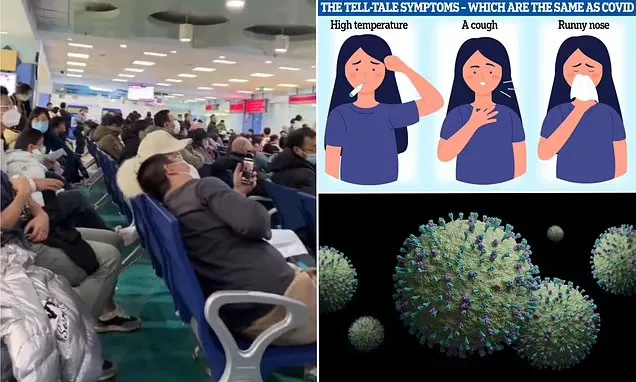
Western experts have publicly called on China to be more transparent about a viral outbreak overwhelming its hospitals - as data shows the virus is growing in the US.
Beijing has downplayed footage of overcrowded waiting rooms and wards posted on social media, saying respiratory infections are 'less severe' and 'smaller in scale' compared to last year.
That has led some to fear there are similarities with the current situation and the Covid outbreak in 2019, which was initially played down by China.
It is thought China's outbreak is being fueled by the relatively unknown virus human metapneumovirus (HPMV), which normally causes cold-like symptoms such as a blocked nose, headache, shivering and tiredness.
Dr Sanjaya Senanayake, infectious disease expert associate professor of medicine at The Australian National University, said it was 'vital for China to share its data on this outbreak in a timely manner', including 'data about who is getting infected.'
He added: 'Also, we will need genomic data confirming that HMPV is the culprit, and that there aren't any significant mutations of concern. Such genomic data will also guide vaccine development.'
Their warning comes as the US experiences its own increase in HMPV cases, with positive test percentages doubling from the beginning to the end of December.
According to the latest CDC data, just under 300 positive test results reported during the last week of December, the latest figures available.
The US CDC said it is 'monitoring' the cases in China but believe they are 'not currently a cause for concern in the US.'
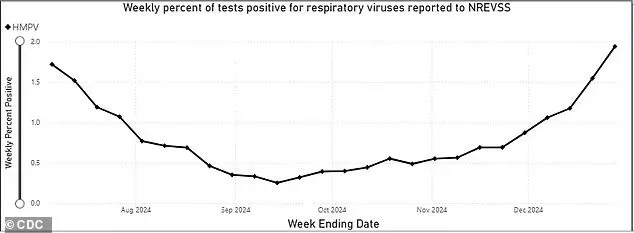
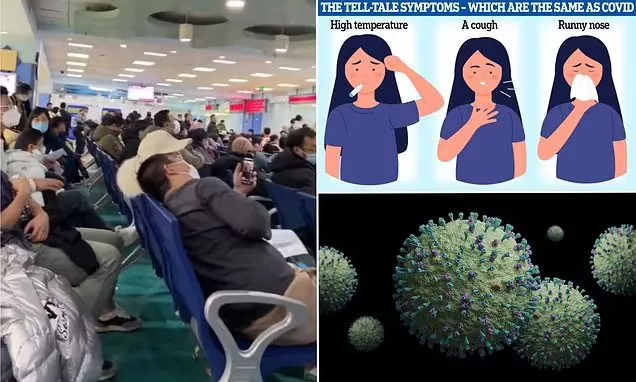
Dr Andrew Catchpole, chief scientific officer at the infectious disease biotech hVIVO, said that while hMPV is typically reported in the colder months, 'it does seem that the rates of serious infection may be higher in China than what we would expect in a normal year.'
He added: 'hMPV is common part of the winter cold causing viruses in most countries with seasonality.
'It is not usual to be a major concern for high numbers of hospitalizations, but it is unclear just how high the numbers are or if issues are arising purely due to coinciding with high flu and COVID levels.'
HMPV first emerged in 2001 and typically causes symptoms of a common cold.
But more severe symptoms such as bronchitis, bronchiolitis and pneumonia can occur, with sufferers experiencing a shortness of breath, severe cough or wheezing.
Children, the elderly and immunocompromised patients are at the highest risk of severe complications.
Because the virus is usually mild, its exact death rate is unknown. But experts estimate anywhere from 10 to 30 percent of patients hospitalized with HMPV die in the US.
Dr Senanayake cautioned that China's increase in HMPV cases is akin to a 'bad flu season' in the US and was not likely to escalate into a global problem.
He said: 'At this stage, the likelihood is that China is experiencing a bad HMPV season, in the same way that in some years we have an overwhelming flu season.
'This could be due to a combination of viral and behavioral factors, but it should settle down.'
Vasso Apostolopoulos, a professor of immunology at RMIT University in Australia, said the surge in cases and growing pressure on healthcare systems in densely populated regions like China shows a need for more surveillance.
She said: 'Ensuring effective monitoring and timely responses will be key to mitigating the public health risks of this outbreak.'
The Chinese CDC has urged people to take precautions like hand washing but has pushed back against claims that hospitals will be overwhelmed.
Chinese foreign ministry spokesperson Mao Ning said: 'Respiratory infections tend to peak during the winter season.
'The diseases appear to be less severe and spread with a smaller scale compared to the previous year.'
Similar to Covid, HMPV spreads through respiratory droplets that circulate in the air when a person coughs or sneezes. Close personal contact like shaking hands and touching contaminated surfaces can also spread the disease.
Researchers estimate one in 10 respiratory illnesses in US children are caused by HMPV.
Fever, cough, congestion, and shortness of breath are the most common symptoms, according to the CDC.
The CDC estimates 20,000 children under five in the US are hospitalized with HMPV every year.
There are no vaccines or specific treatments for the disease.
Professor John Tregoning, an expert in vaccine immunology at Imperial College London, said: 'HMPV (human metapneumovirus) is not a new virus, it was first isolated in 2001 but most likely has been circulating for much longer.
'It has very similar symptoms (in children at least) to RSV (respiratory syncytial virus). It is part of the cocktail of winter viruses that we are exposed to.
'As with all respiratory viruses, there will be a range of symptoms and severity. Risk factors will include age (either very young or very old) and underlying immunosuppression.
'Like other viruses it will transmit in coughs, sneezes and in droplets. Protecting yourself by being in well ventilated, covering your mouth when you cough, washing your hands will all help.
'It will present in the same way as flu, sars-cov-2, RSV, so the same advice applies for those affected - rest, take on fluids, try not to spread it to others.'
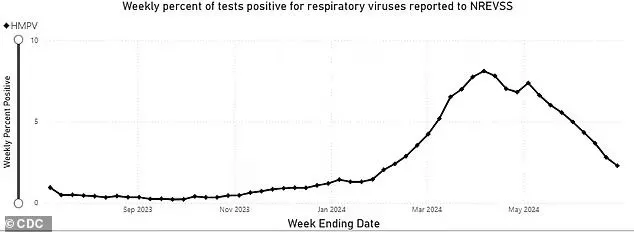


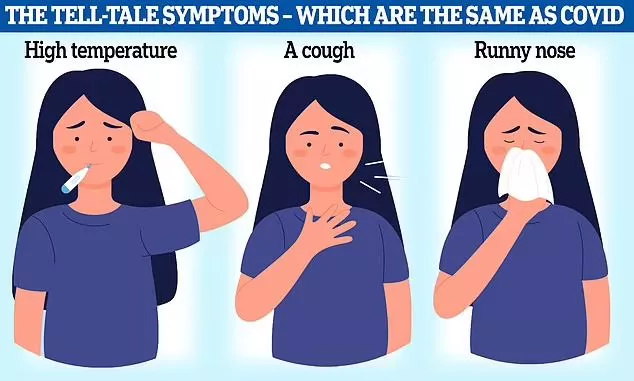
Professor Jill Carr, a virologist in the College of Medicine and Public Health at Flinders University in Australia, cautioned the current outbreak in China was not likely to cause a global crisis.
She said: 'This is very different to the COVID-19 pandemic, where the virus was completely new in humans and arose from a spill-over from animals and spread to pandemic levels because there was no prior exposures or protective immunity in the community.
'The scientific community also has some understanding of the genetic diversity and epidemiology of HPMV, the kind of impact the virus has on the lungs and established laboratory testing methods - again, very different to the COVID-19 pandemic, where a new lung disease was seen, there was little information on how the virus may vary and spread and we had no initial diagnostic tests.'
Andrew Easton, a virology professor at the University of Warwick in the UK, told Live Science: 'HMPV has been recognized as a significant problem in the at-risk population across the world since the turn of the century when it was first discovered.
'That risk has not changed significantly over the last almost 25 years.'
According to the National Respiratory and Enteric Virus Surveillance System (NREVSS), a CDC database, US cases of HMPV are on the rise compared to this time last year.
Data from the week of December 28, the latest available, shows a test positivity rate of 1.9 percent. Out of about 13,800 total tests for that week, that adds up to just under 300 confirmed cases.
The test positivity rate for the week of November 30 was 0.9, half that of the month after.
And at this time last year, the CDC recorded a 1.2 percent test positivity rate.
However, Paul Hunter, professor in medicine at the University of East Anglia in the UK, said that it can be difficult to detect year-over increases because HMPV is detected with molecular tests like PCR tests, which are used to detect Covid.
He said: 'One of the issues involved in these types of infection is that they are being diagnosed more frequently as we move to molecular diagnostic panels, so it is not always easy to know whether year on year increases are due to actual increases or just because we are diagnosing a greater proportion of infections.
He noted that while the UK has seen a 'marked increase in recent weeks' similar to the US, cases are roughly similar to this time last year.
He said: 'So overall, I don't think there is currently any sign of a more serious global issue.'
Dr Jacqueline Stephens, a senior lecturer in public health at Flinders University in Australia, said: 'I think we're just more cautious of outbreaks now.
'Everyone is hypervigilant, and you hear this term human metapneumovirus and it sounds kind of scary.'
A US CDC spokesperson told Nexstar: 'CDC is aware of reported increases of HMPV in China and is in regular contact with international partners and monitoring reports of increased disease.
'These reports are not currently a cause for concern in the US.'


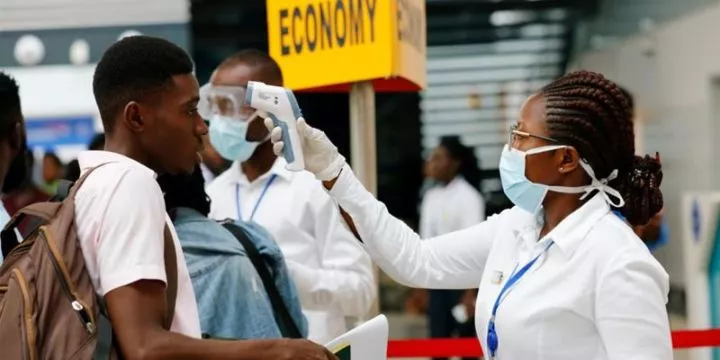

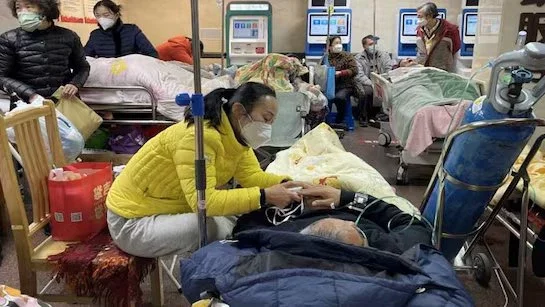











Comments